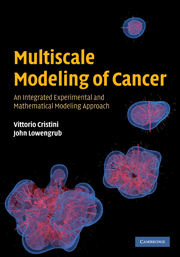11 - Conclusion
from Part II - Applications
Published online by Cambridge University Press: 05 October 2010
Summary
Tumors are complex systems dominated by large numbers of processes with highly nonlinear dynamics spanning a wide range of dimensions. Typically, such complex systems can be understood only through complementary experimental investigation and mathematical modeling. New methodologies are needed to integrate and quantify the myriad variables and enable the prediction of outcomes, the selection of existing therapies, and the development of new treatments, possibly on a personalized, individual, basis. Mathematical modeling can provide a rigorous, precise, approach for quantifying correlations between tumor parameters, prognosis, and treatment outcomes. Integration of these elements into a multidisciplinary model of tumor progression would be an important tool to advance clinical decision-making. Thus, there is a critical need for biologically realistic and predictive multiscale and multivariate models of tumor growth and invasion and, as we have seen in this book, there has been much recent effort directed towards this goal.
The tumor models and simulation results that we have reviewed demonstrate that, while mathematical analyses still lag behind experimentation, significant progress has been made in providing important insights into the root causes of solid-tumor invasion and metastasis and in providing and assessing effective treatment strategies. For example, the results provide a means to associate quantitatively tumor growth and the effects of a limited supply of cell substrates. Inhomogeneities in the substrate availability and/or host tissue biomechanical properties can result in tumor morphological instability. These instabilities may allow a tumor to overcome diffusional limitations on growth and to grow to sizes larger than would be possible if it had a compact shape.
- Type
- Chapter
- Information
- Multiscale Modeling of CancerAn Integrated Experimental and Mathematical Modeling Approach, pp. 235 - 237Publisher: Cambridge University PressPrint publication year: 2010



